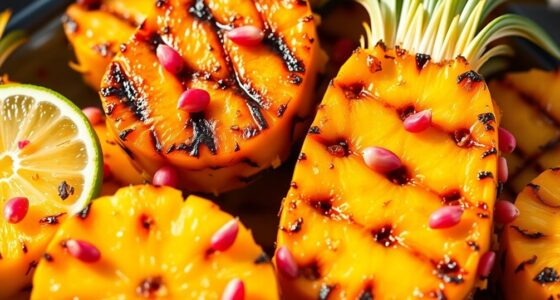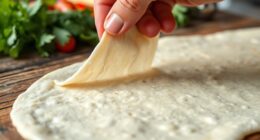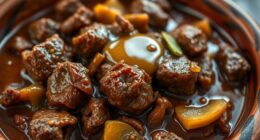Pierre Hermé's fruit cake blends creamy milk chocolate with the tang of passion fruit, creating a delightful dessert experience. Its textured layers feature a biscuit base soaked in fruity syrup, all wrapped around a luscious ganache. Perfect for any occasion, it showcases innovative flavors that elevate traditional recipes. You'll love how the contrasting sweetness and acidity come together in each bite. If you're curious about more details, just keep on exploring further!
History
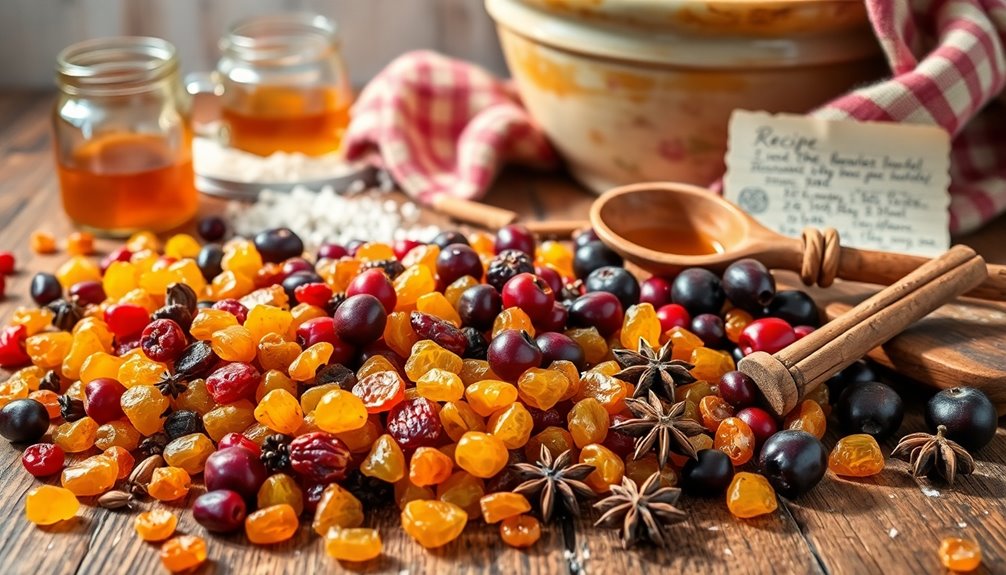
Although fruit cakes have a long-standing tradition in pastry, Pierre Hermé revolutionized their appeal by introducing innovative flavor combinations, particularly with his signature Mogador desserts.
By artfully blending chocolate and passion fruit, Hermé created a cake that not only tantalizes the taste buds but also showcases the versatility of these ingredients. His Mogador cake, featuring a passion fruit pound cake enveloped in milk chocolate and passion fruit ganache, exemplifies his commitment to high-quality components and artistic presentation.
This unique pairing has inspired contemporary pastry chefs to explore exotic flavours, pushing the boundaries of traditional desserts. As a result, Hermé's influence has led to a growing trend of fruit-infused cakes, reflecting both evolution and a fresh approach to classic recipes. Additionally, his approach parallels the use of creamy textures found in dishes like Mushroom Risotto, highlighting the importance of texture in dessert innovation.
Recipe

Indulge in the exquisite flavors of Pierre Hermes Fruit Cake, a delightful fusion of milk chocolate and the zesty notes of passion fruit. This recipe showcases a creamy and tender cake that balances the sweetness of chocolate with the refreshing acidity of passion fruit, making it a perfect treat for any occasion. The cake is enriched with a luscious ganache and finished with a dark chocolate icing that adds an elegant touch.
To begin, you'll need to create a flavorful biscuit base that serves as the foundation for your cake. This involves whipping together egg yolks and sugar, folding in stiffly beaten egg whites, and baking it to perfection. Once the biscuit is ready, it will be soaked in a homemade passion fruit syrup that enhances the cake's moisture and flavor. The assembly process involves layering the ganache, rolling up the biscuit, and finally icing it for a stunning presentation.
Ingredients
- 350g milk chocolate
- 70g room temperature butter
- Passion fruit juice (amount as needed)
- Egg yolks (number as needed)
- Sugar (amount as needed)
- Egg whites (number as needed)
- Water (105g)
- Sugar (115g for syrup)
- Passion fruit juice (105ml for syrup)
- Dark chocolate icing (amount as needed)
Cooking Instructions
Start by preheating your oven to 230°C (446°F). In a mixing bowl, beat the egg yolks with sugar until pale and creamy. In a separate bowl, whip the egg whites until stiff peaks form. Gently fold the whipped egg whites into the egg yolk mixture until combined. Bake the mixture for 5-6 minutes until golden and set.
While the biscuit is cooling, prepare the passion fruit syrup by boiling 105g of water with 115g of sugar, then allowing it to cool before adding 105ml of passion fruit juice. For the ganache, chop the milk chocolate and mix it with room temperature butter and heated passion fruit juice until smooth.
Assemble the cake by soaking the biscuit with syrup, spreading the ganache, rolling it up, and then applying dark chocolate icing. Regular consumption of ice cream may lead to weight gain, so it's important to enjoy treats like this fruit cake in moderation.
Extra Tips
When making the ganache, ensure that the passion fruit juice is heated but not boiling to avoid seizing the chocolate. Allow the biscuit to cool completely before soaking it in syrup to prevent it from becoming too soggy.
For a decorative finish, consider garnishing the cake with fresh passion fruit pulp or chocolate shavings. Additionally, if you want an extra layer of flavor, you can experiment with adding a touch of vanilla or a hint of citrus zest to the ganache. Enjoy your baking!
Cooking Steps

To kick off your baking process, start by preheating the oven to 350°F.
Next, mix your dry ingredients thoroughly before folding in the wet ones.
Don't forget to add your fruit and nuts for that perfect finish! Additionally, consider serving your cake with a scoop of sugar-free vanilla ice cream for a delightful contrast of flavors.
Step 1. Preheat Oven to 350°F

Preheating your oven to 350°F (about 175°C) is essential for baking a delicious Pierre Hermé-inspired fruit cake. This temperature ensures even baking and helps activate the leavening agents in your batter, resulting in a light and fluffy texture.
To achieve the perfect rise, it's crucial to properly preheat your oven; otherwise, you risk ending up with a dense cake. Make sure to allow the oven to preheat for at least 15-20 minutes before you place your fruit cake inside.
Using an oven thermometer is a smart move, as many home ovens can be off by several degrees. This way, you can be confident that your oven is at the right temperature for baking success. Additionally, ensuring color accuracy during the baking process can help you achieve the best results in terms of appearance and taste.
Step 2. Mix Dry Ingredients Thoroughly
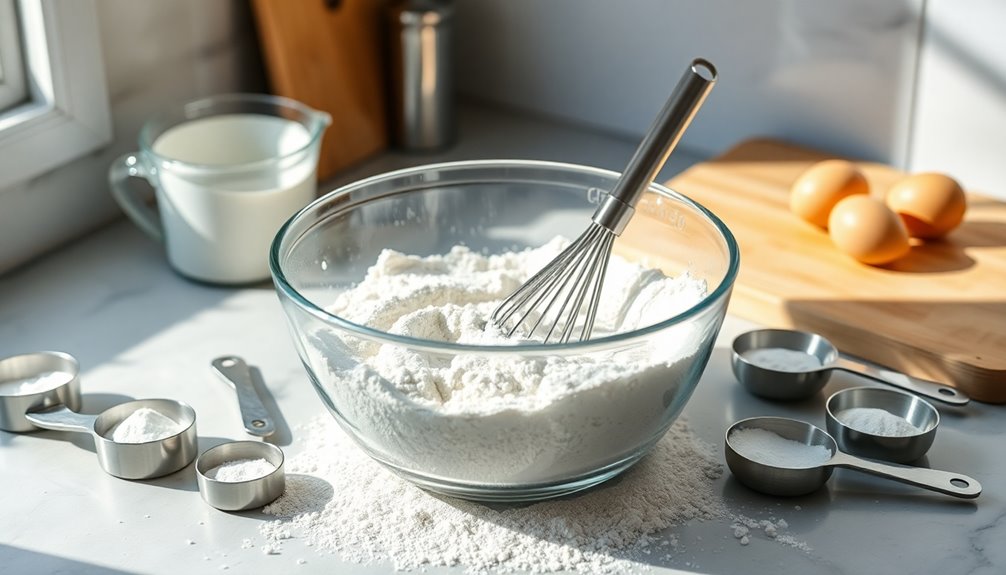
Mixing your dry ingredients thoroughly is a crucial step in creating a perfectly baked Pierre Hermé fruit cake.
Start by measuring your flour, sugar, baking powder, and spices accurately. This ensures even distribution and prevents imbalances in flavor and texture.
Sift these dry ingredients together to eliminate clumps and improve aeration, which helps your cake rise properly.
Don't forget to add a pinch of salt to enhance the overall flavor profile and balance the sweetness of the cake.
Once you've mixed dry ingredients thoroughly, create a well in the center. This will help when you add wet ingredients later, promoting better incorporation and minimizing any lumps.
Following this step sets the foundation for a delightful cake! Additionally, using unsalted butter in your recipe allows for better control over the sweetness and saltiness, further enhancing the flavor of your fruit cake.
Step 3. Fold in Wet Ingredients

Gently fold in the wet ingredients to your dry mixture, ensuring you maintain the batter's lightness and airiness.
Start by adding your room-temperature melted butter and passion fruit juice gradually, mixing in three portions. This helps achieve a smooth consistency without overmixing.
Use a rubber spatula or wooden spoon to carefully fold, scraping the sides and bottom of the bowl to eliminate lumps.
The ideal folding technique will keep the whipped egg whites intact, which is crucial for your cakes' rise and tender crumb.
Remember, the goal is to create a homogenous mixture while preserving the airiness that makes your fruit cake delightful. Additionally, using high-quality butter can enhance the flavor and richness of your cake.
Enjoy the process, and watch your batter transform beautifully!
Step 4. Add Fruit and Nuts
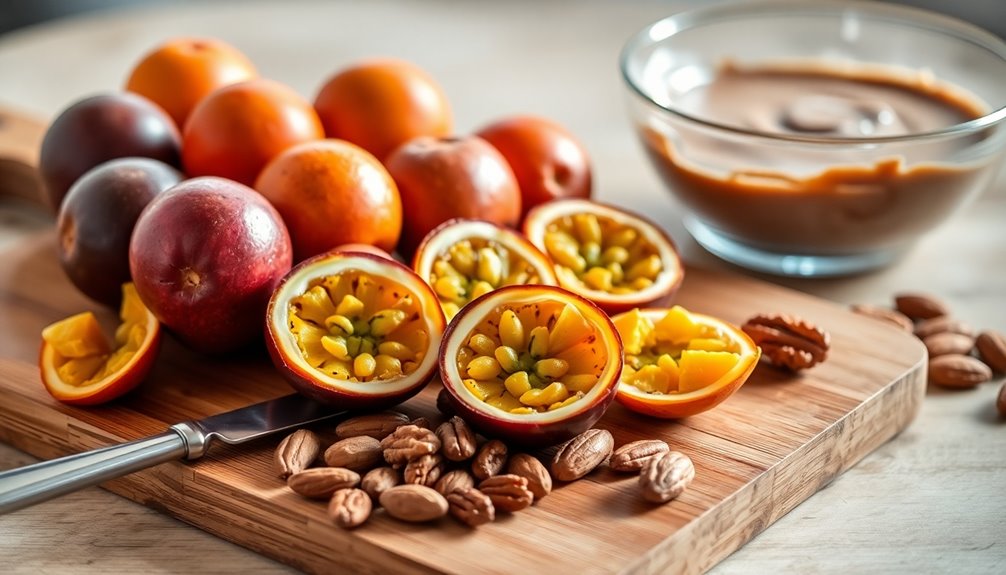
As you prepare to add the fruit and nuts, soak your dried fruits like apricots, figs, or cranberries in a splash of passion fruit juice or rum for a few hours to boost their flavor and moisture.
Once they're plump and flavorful, chop them into small pieces for even distribution throughout the cake.
Next, consider adding some chopped nuts, such as almonds or hazelnuts, to provide a delightful crunch that complements the sweetness of the fruits.
Gently fold the soaked dried fruits and nuts into the batter, being careful not to overmix, as this can lead to a denser cake.
For a finishing touch, sprinkle some chopped nuts on top before baking to enhance the cake's presentation. Additionally, incorporating high fiber ingredients like nuts can contribute to digestive health, aligning with the benefits of a vegetarian diet.
Step 5. Bake for 50 Minutes
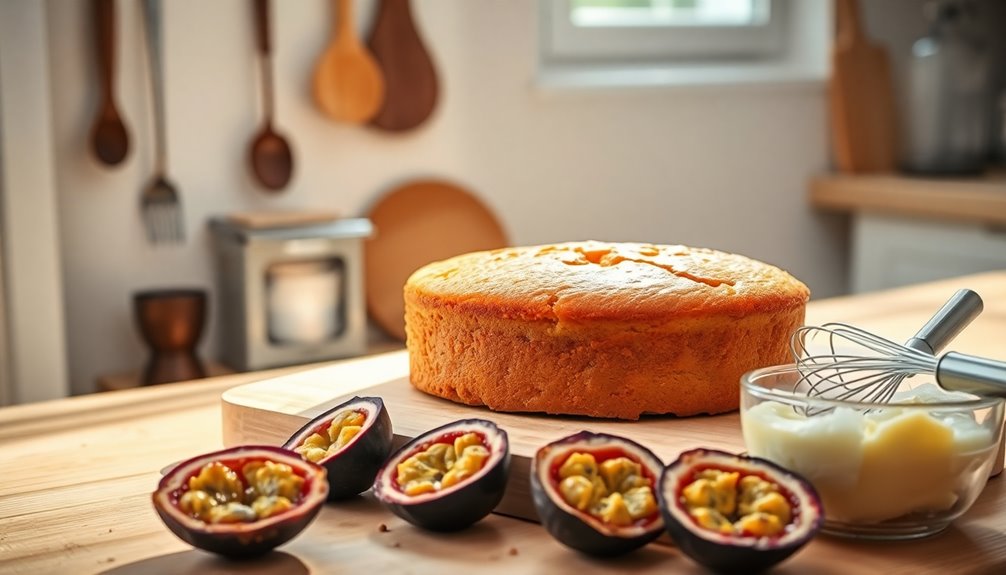
Once you've incorporated the soaked fruits and nuts into the batter, it's time to bake your masterpiece.
Preheat your oven to around 230°C (446°F) to ensure even cooking for your fruit pound cake. Line your baking pan with parchment paper to prevent sticking and make removal easier.
Carefully pour the batter into the prepared pan and bake for 50 minutes. Keep an eye on it during the last few minutes to avoid over-browning; you can adjust the temperature if needed.
To check for doneness, insert a skewer into the center—if it comes out clean, your cake is ready.
After baking, let the fruit cake cool in the pan briefly before transferring it to a wire rack to cool completely. For added enjoyment, consider serving it with a side of cream cheese frosting to enhance the flavors.
Final Thoughts
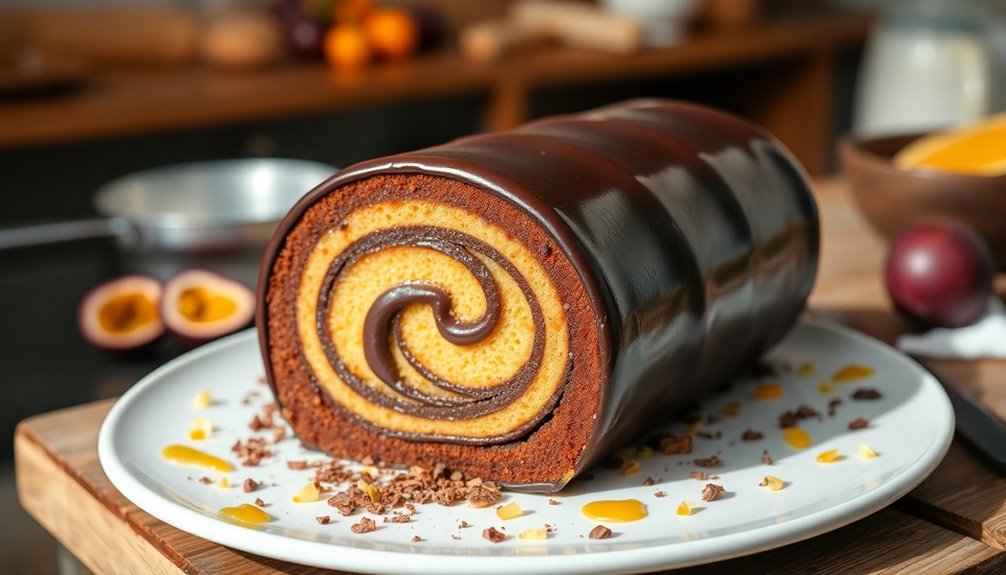
Indulgence in Pierre Hermé's fruit cakes offers a unique experience that transcends ordinary desserts. The Mogador Cake, with its luscious blend of milk chocolate and passion fruit, creates a creamy, tender texture that perfectly balances the fruit's acidity.
At €28.00 for a 500g size, you're investing in high-quality ingredients and craftsmanship that truly shine in each bite. Hermé's commitment to innovation is evident in the seasonal variations, like the Ispahan and Infiniment Citron cakes, which keep your taste buds excited throughout the year.
Designed for sharing, these cakes are perfect for gatherings or special occasions. Plus, with home shipping options and free shipping on orders over €75, treating yourself to these delights has never been easier. Additionally, the use of high-quality ingredients in these cakes elevates their flavor profile, reminiscent of the rich, creamy taste that butter adds to baked goods.
Frequently Asked Questions
What Is the Most Expensive Fruit Cake?
The most expensive fruit cake ever sold was valued at $3,000, setting a Guinness World Record in 2019.
This lavish creation featured rare fruits and intricate designs, showcasing the pinnacle of luxury baking.
If you're curious about why fruit cakes can reach such high prices, it typically comes down to the quality of ingredients and the artistry involved in crafting them.
You might be surprised at how much effort goes into these decadent delights!
Who Invented the Christmas Fruit Cake?
Did you know that over 80 million fruit cakes are sold each year during the holiday season?
The origin of the Christmas fruit cake isn't tied to a single inventor. Instead, it evolved over centuries, with roots tracing back to ancient Rome.
What Ethnicity Is Fruit Cake?
Fruit cake doesn't belong to a single ethnicity; it's a delightful blend of cultures.
You'll find variations across different regions, each adding local ingredients. For instance, the British version often incorporates dried fruits and spices, while Caribbean fruit cake, or black cake, features rum-soaked fruits.
Its origins trace back to ancient Rome, showcasing how diverse influences have shaped this dessert.
How to Age a Christmas Fruit Cake?
To age a Christmas fruit cake, start by wrapping it tightly in parchment paper and aluminum foil. This keeps air and moisture out.
Store the wrapped cake in an airtight container in a cool, dark place, ideally between 14°C and 16°C.
Every few weeks, unwrap it and lightly brush it with alcohol like brandy or rum to boost flavor and moisture.
For the best results, age it for 3-6 weeks before enjoying.
Conclusion
In the end, making Pierre Hermé's fruit cake isn't just about following a recipe; it's a celebration of flavors and tradition. As you blend the fruits and spices, you're weaving a story that connects you to generations of bakers who've perfected this craft. So, while you savor each bite, remember that food is more than sustenance; it's a way to share love and create memories, reminding us of the beauty in every shared experience.





